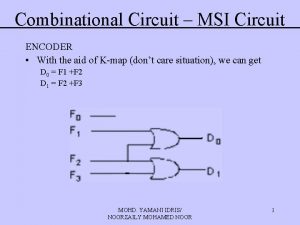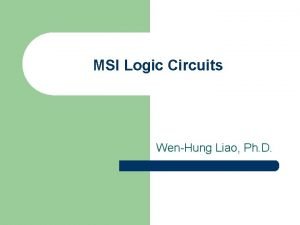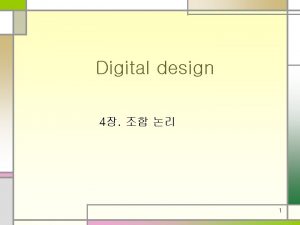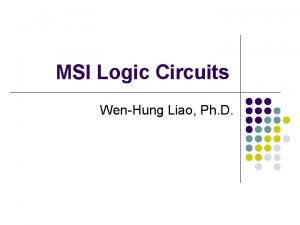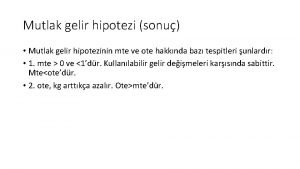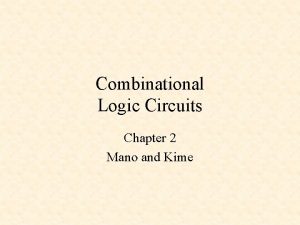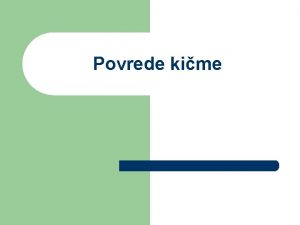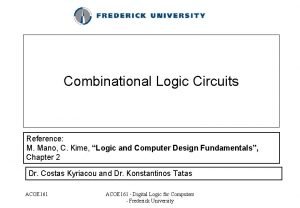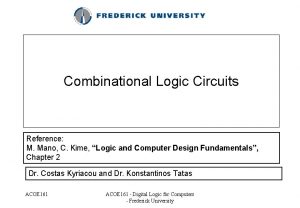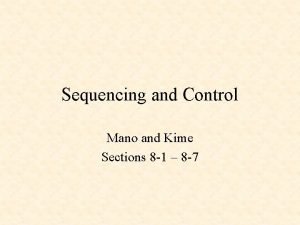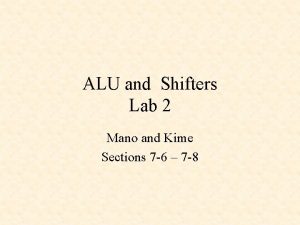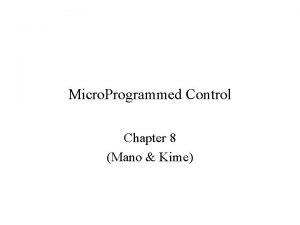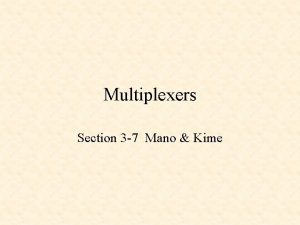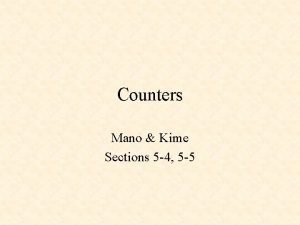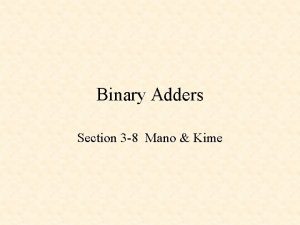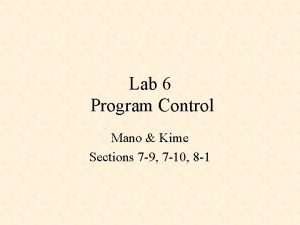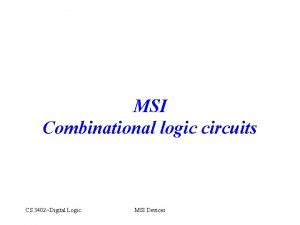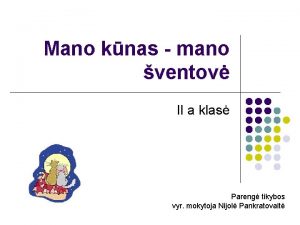MSI Devices M Mano C Kime Logic and



















- Slides: 19

MSI Devices M. Mano & C. Kime: Logic and Computer Design Fundamentals (Chapter 5) Dr. Costas Kyriacou and Dr. Konstantinos Tatas ACOE 161 - Digital Logic for Computers - Frederick University

MSI Devices • Medium Scale Integration (MSI) devices are digital devices that are build using a few tens to hundreds of logic gates. • MSI devices are used as discrete devices packed in a single Integrated Circuit (IC), or as building blocks for other, more complex devices such as memory devices or microprocessors. • Some typical MSI devices are the following: – Encoders and Decoders – Multiplexers and Demultiplexers – Full Adders – Latches and flip flops – Registers and Counters ACOE 161 - Digital Logic for Computers - Frederick University

Examples of MSI Devices Decimal to BCD Encoder 4 -to-1 Multiplexer BCD to Decimal Decoder ACOE 161 - Digital Logic for Computers - Frederick University

Decoders • A decoder is a combinational digital circuit with a number of inputs ‘n’ and a number of outputs ‘m’, where m= 2 n • Only one of the outputs is enabled at a time. The output enabled is the one specified by the binary number formed at the inputs of the decoder. • On the circuit below, the inputs of the decoder are connected on three switches, forming the number 5 [(101)2], thus only LED #5 will be ON ACOE 161 - Digital Logic for Computers - Frederick University

2 to 4 Line Decoder: ACOE 161 - Digital Logic for Computers - Frederick University

3 to 8 Line Decoder: ACOE 161 - Digital Logic for Computers - Frederick University

3 to 8 Line Decoder: (Implementation using two 2 -to-4 decoders) ACOE 161 - Digital Logic for Computers - Frederick University

3 to 8 Line Decoder: (Implementation using two 2 -to-4 decoders) ACOE 161 - Digital Logic for Computers - Frederick University

4 to 16 Line Decoder: (Implementation using four 2 -to-4 decoders) ACOE 161 - Digital Logic for Computers - Frederick University

ENCODERS • • • A decoder in general is a combinational digital circuit with a number of inputs ‘m’ and a number of outputs ‘n’, where n = log 2 m A binary encoder has precisely the opposite functionality of the binary decoder. A priority encoder is a special case of encoder used in computer interrupt mechanisms to specify which device requests service and prioritize interrupts that occur at the same time I 3 I 2 I 1 I 0 O 1 O 0 V 0 0 X X 0 0 1 X 0 1 1 0 1 X X 1 0 1 1 X X X 1 1 1 ACOE 161 - Digital Logic for Computers - Frederick University 10

Multiplexers • A multiplexer is a device that has a number of data inputs “m”, and number of control inputs “n” and one output, such that m=2 n. The output has always the same value as the data input specified by the binary number at the control inputs. • The rotary switch (selector) shown in figure (a) below, is equivalent to a 4 -to-1 multiplexer. • The sliding switch shown in figure (b) below, is equivalent to an 8 -to-1 multiplexer. ACOE 161 - Digital Logic for Computers - Frederick University

Internal structure of a 2 -to-1 multiplexer. • The design of a 2 -to-1 multiplexer is shown below. • If S=0 then the output “Y” has the same value as the input “I 0” • If S=1 then the output “Y” has the same value as the input “I 1” ACOE 161 - Digital Logic for Computers - Frederick University

4 -to-1 Multiplexer (MUX) S S O 1 0 0 0 I 0 0 1 I 1 1 0 I 2 1 1 I 3 ACOE 161 - Digital Logic for Computers - Frederick University 13

1 -bit Full Adder ACOE 161 - Digital Logic for Computers - Frederick University 14

4 -bit Full Adder (Ripple-Carry Adder) • To obtain a 4 -bit full adder we cascade four 1 -bit full adders, by connecting the Carry Out bit of bit column M to the Carry In of the bit column M+1, as shown below. The Carry In of the Least Significant column is set to zero. • Example: Find the bit values of the outputs {Cout, S 3. . S 0} of the full adder shown below, if {A 3. . A 0 = 1011} and {B 3. . B 0 = 0111}. ACOE 161 - Digital Logic for Computers - Frederick University 15

Example • Design a 4 -bit adder/subtracter using Full-adders and gates. ACOE 161 - Digital Logic for Computers - Frederick University

Magnitude Comparator ACOE 161 - Digital Logic for Computers - Frederick University 17

Review questions • How many input/output signals are present in a – 5 -to-32 decoder? – 32 -to-1 MUX? – 32 -bit Ripple-Carry Adder (RCA)? • • How many 2 -to-1 MUXs are required to build a 32 -to-1 MUX? Design a logic unit with 2 data inputs (A, B), three select inputs (S 2, S 1, S 0) and the following specifications: S 2 S 1 S 0 O 0 0 0 A AND B 0 0 1 A OR B 0 1 0 A XOR B 0 1 1 A NAND B 1 0 0 A NOR B 1 0 1 A XNOR B 1 1 0 A΄ 1 1 1 B΄ ACOE 161 - Digital Logic for Computers - Frederick University 18

Review questions 2 • Use two 4 -to-1 MUXs to build a full adder • Implement the following Boolean algebra equation using only a single 8 -to-1 MUX: F(A, B, C, D) = Σ(0, 3, 5, 6, 8, 9, 14, 15) ACOE 161 - Digital Logic for Computers - Frederick University
 Msi circuit examples
Msi circuit examples Http://www.biografiasyvidas.com
Http://www.biografiasyvidas.com Msi logic
Msi logic 4 bit parallel adder subtractor
4 bit parallel adder subtractor Msi logic
Msi logic Arzu listesi okul öncesi
Arzu listesi okul öncesi Zıt tepki yöntemi örnek
Zıt tepki yöntemi örnek Adalet evrenin ruhudur sözü kime aittir
Adalet evrenin ruhudur sözü kime aittir Tüm sebzeler
Tüm sebzeler Edep ve haya vaaz
Edep ve haya vaaz Mutlak gelir teorisi
Mutlak gelir teorisi Alkolik kime denir
Alkolik kime denir Ryan kime
Ryan kime First order logic vs propositional logic
First order logic vs propositional logic First order logic vs propositional logic
First order logic vs propositional logic Third order logic
Third order logic Combinational logic vs sequential logic
Combinational logic vs sequential logic Tw
Tw Project management plan example
Project management plan example Is it x y or y x
Is it x y or y x
